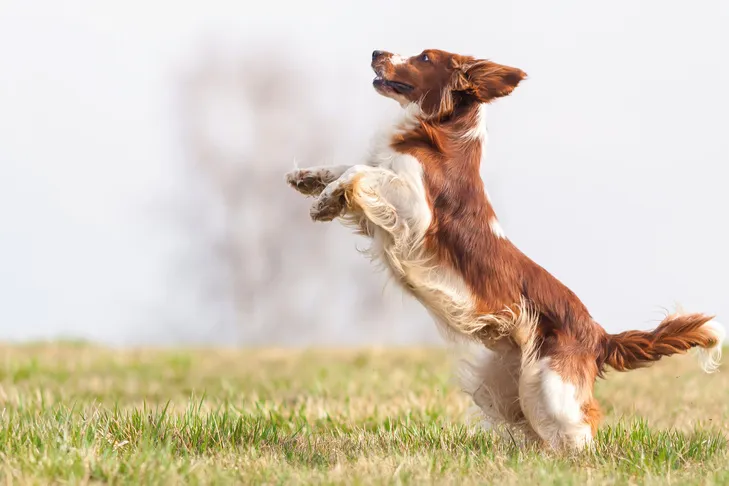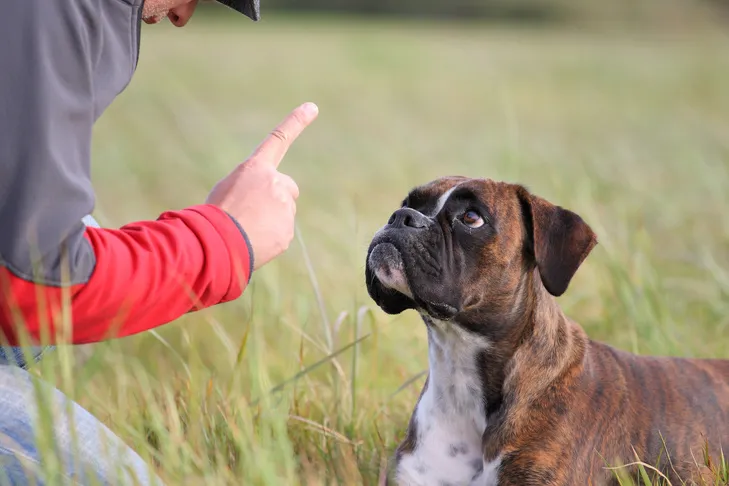Greeting enthusiasm is a wonderful trait in dogs, but when it manifests as jumping, it can quickly become an unwelcome and even dangerous behavior. For dog owners, understanding how to effectively manage and prevent this common issue is crucial for a harmonious household and safe interactions with guests. Jumping up is a natural canine greeting, often an attempt to get closer to your face or simply gain attention. However, whether you own a large breed that could easily knock someone over or a smaller dog that leaves muddy paw prints, teaching your dog an alternative, more polite greeting is essential. This guide, focusing on the key phrase “How To Get Dog From Jumping On You,” offers practical, positive reinforcement techniques to help your furry friend learn appropriate etiquette when meeting people.
1. Only Greet Your Dog When All Four Paws Are on the Floor
The most effective strategy for dealing with problematic behaviors is to teach an incompatible alternative. Instead of focusing on what not to do, guide your dog on what to do. For jumping, this means rewarding them only when all four paws remain on the ground. They cannot jump and stand simultaneously. Alternatively, you might teach them to sit or lie down for greetings. The key is consistency: always greet and provide attention only when your dog adheres to your chosen rule. Avoid sending mixed signals, such as allowing jumping in casual attire but not in formal wear.
2. Provide Immediate Attention When Your Dog’s Front Feet Hit the Floor
Dogs are intelligent and quickly learn to repeat behaviors that yield desired outcomes. Therefore, as soon as your dog’s front feet return to the floor, immediately reward them with praise and petting. Your attention is a powerful motivator. Ensure this positive reinforcement is instant, especially during the learning phase. Delaying your greeting, perhaps while you take off your coat, might lead to impatience and encourage your dog to try jumping again to get your notice.
3. Withdraw Attention When Your Dog Jumps
Conversely, to stop jumping, you must cease reinforcing it. Never reward a behavior you wish to eliminate. If your dog jumps, swiftly remove the attention they crave. Turn your back or calmly walk away, demonstrating that jumping achieves the opposite of their intention. The moment your dog returns to a “four on the floor” stance, turn back and quietly offer praise and a gentle pet. This method teaches your dog that their behavior directly controls the presence or absence of your attention.
 Welsh Springer Spaniel jumping up outdoors.
Welsh Springer Spaniel jumping up outdoors.
4. Set Your Dog Up for Success
While ignoring jumping and rewarding proper greetings is effective, it can be a trial-and-error process for your dog. Facilitate their learning by making it easier for them to follow the greeting rule. If “sit” is your rule, ask them to sit as soon as you enter. If “four on the floor” is the goal, encourage them to remain standing. A fantastic way to prevent jumping is to scatter treats on the floor upon entry. Most dogs find free goodies irresistible and cannot jump while sniffing the ground. Be quick; if you provide food before they even consider jumping, you reinforce keeping all four paws down with both attention and treats. Your dog will quickly understand the rule, allowing you to gradually phase out the food rewards.
5. Consistently Reward Proper Greeting Behavior
Your dog will grasp appropriate greeting behavior more rapidly if their actions have immediate and consistent consequences for your attention. Feet on the floor earns attention, while jumping makes it disappear. This means you must always reward your dog when they follow your greeting rule. Even if you’re frustrated after a long period of jumping, never withhold attention once their feet are down. Inconsistency will confuse your dog and hinder the learning process.
6. Avoid Grabbing or Pushing Your Dog Away
Remember that your dog is seeking your attention through jumping. Even a negative physical response, such as grabbing, holding their paws, or pushing them away, still constitutes attention and thus inadvertently reinforces the jumping. This can lead to an increase in jumping over time. Worse, for many dogs, such physical interactions can be misinterpreted as an invitation to roughhouse play. They may return with more vigorous jumping, believing it’s part of a game.
 American Hairless Terrier jumping up on the leg of its owner outdoors.
American Hairless Terrier jumping up on the leg of its owner outdoors.
7. Do Not Use Your Knee to Block Your Dog
The advice to use your knee to block your dog’s chest when they jump is often misguided. As previously mentioned, this action can be seen as attention or even a wrestling match by some dogs, potentially increasing the behavior. More importantly, for most dogs, this creates distrust and can erode the vital human-canine bond. Your dog is simply trying to say “hello,” and being met with a knee can be perceived as punishment. This can even cause injury or lead to other behavioral problems if your dog loses trust, such as not coming when called.
8. Keep Greetings Low-Key While Your Dog Is Learning
Dogs, especially puppies, find it challenging to control their excitement when greeting you. Resisting the natural urge to jump and instead obeying a new greeting rule requires significant emotional self-control. Make this easier for your dog by keeping your greetings low-key. Dogs are adept at reading our emotions; if you are overly excited, they will mirror that energy. Instead, maintain a calm and quiet demeanor, even when offering praise. As your dog begins to grasp the new behavior, you can gradually increase your enthusiasm until you can match their joy without encouraging jumping. Teaching your puppy positive behaviors early, such as training your puppy to walk on a lead, can help with overall self-control.
9. Prevent Your Dog From Jumping on Guests
Your dog’s jumping behavior isn’t only reinforced by you; other family members, guests, and even strangers can inadvertently reward it. To manage this, employ preventative techniques. Consider using a leash to control their approach, especially when new people arrive. Even better, teach your dog to “go to their place,” such as a mat or bed, or use crate training so they are not near the door. A baby gate can also be an effective barrier to block access to the front hall, ensuring proper behavior when visitors enter.
 Boxer laying down outdoors being trained by a man.
Boxer laying down outdoors being trained by a man.
10. Instruct Guests and Strangers on Your Greeting Rule
Don’t hesitate to clearly communicate your dog’s greeting rules to guests and even strangers. While your dog is still learning, ask people to completely ignore your dog unless you indicate it’s appropriate to interact. Try to avoid interactions with strangers until your dog has consistently mastered greetings with cooperative friends and family. If you encounter a stranger, use a “watch me” cue or distract your dog with a hand touch or a favorite toy until the person has passed.
Dealing with a dog that jumps can be frustrating, but with consistency, patience, and positive reinforcement, you can effectively teach your dog how to greet people politely. By understanding why dogs jump and providing clear alternatives, you’ll foster a more respectful and enjoyable relationship with your canine companion. These strategies will help you get your dog from jumping on you, creating calmer interactions for everyone.
